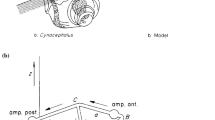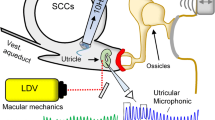Abstract
The transparent labyrinth of young eels (Anguilla anguilla L.) was used in toto for studying the configuration of cupula displacement, deflection of the hair bundle, and correlated changes in transepithelial voltage (ΔTEV) and nerve activity (ΔNA) in the semicircular canal. Microcapillaries were introduced into the canal through holes produced by a microthermocauter. Mechanical stimulation was applied either by injection of fluid into the ampulla or by electromagnetically displacing ferrofluid as a piston within the canal. Motion of individual kinocilia, stained cupulae or the ferrofluid piston was analysed by double-exposed microphotographs, photodiodes, or a video-system. The three-dimensional cupula displacement configuration was found to be piston-to diaphragm-like. Hair bundles at different sites on the crista exhibit differences in amplitude and time course of deflection. The transfer factor between shifts of the canal fluid and the tips of the kinocilia is 0.4–0.6. Displacements in opposite directions induce ΔTEV and ΔNA of opposite sign. Various tests confirmed ΔTEV to reflect receptor potential responses. Nerve activity adapts to a tonic response with a time constant of 6.4s. No similar adaptation occurred in ΔTEV. Stimulus-response curves of TEV- and NA-responses are similar and signoid in shape with saturation at ciliary deflections of roughly + 6° and −3°.
Similar content being viewed by others
References
Adrian ED (1931) The microphonic action of the cochlea: An interpretation of Wever and Bray's experiments. J Physiol (Lond) 71:28–29
Belanger LF (1961) Observations on the intimate structure and composition of the chick labyrinth. Anat Rec 139:5–45
Blanks RHI, Estes MS, Markham CH (1975) Physiological characteristics of vestibular first order canal neurons in the cat. II. Response to constant angular acceleration. J Neurophys 38:1250
Carpenter D, Swann J, Yarowsky P (1977) Effects of curare on responses to different putative neurotransmitters in Aplysia neurons. J Neurobiol 8:119–132
Colquhoun D, Dreyer F, Sheridan RE (1979) The action of tubocurarin at the frog neuromuscular junction. J Physiol 293:247–284
Corey DP, Hudspeth AJ (1983) Analysis of the microphonic potential of the bullfrog sacculus. J Neurosci 3:942–961
Curthoys IS (1981) The response of primary semicircular canal neurons to angular accelerations of varying magnitude. In: Gualtierotti T (ed) The vestibular system. Springer, Berlin Heidelberg New York, pp 367–373
Curthoys IS, Oman CM (1986) Dimensions of the horizontal semicircular duct, ampulla and utricle in rat and guinea pig. Acta Otolaryngol 101:1–10
Curthoys IS, Oman CM (1987) Dimension of the horizontal semicircular duct, ampulla and utricle in the human. Acta Otolaryngol 103:254–261
Curthoys IS, Markham CH, Curthoys EJ (1977) Semicircular duct and ampulla dimensions in cat, guinea pig and man. J Morphol 151:17–34
Davis H (1965) A model for transducer action in the cochlea. Cold Spring Harbor Symp Quant Biol 30:181–190
Dohlman GF (1935) Some practical and theoretical points in labyrinthology. Proc R Soc Med 28:65–78
Dohlman GF (1969) The shape and function of the cupula. J Laryngol Otol 83:43–53
Dohlman GF (1971) The attachment of the capulae, otolith and tectorial membranes to the sensory cell areas. Acta Otolaryngol 71:89–105
Dohlman GF (1980) Critical review of the concept of cupula function. Acta Otolaryngol 376 (Suppl):1–30
Eatock RA, Corey DP, Hudspeth AJ (1987) Adaptation of mechanoelectrical transduction in hair cells of the bullfrog's sacculus. J Neurosci 7:2821–2836
Enger PS (1964) Ionic composition of the cranial and labyrinthine fluids and saccular D.C. potentials in fish. Comp Biochem Physiol 11:131–137
Eßeling K (1986) Untersuchungen zur mechanoelektrischen Transduktion an isolierten Bogengangsampullen von Fischen. Diplomarbeit, Fachbereich Biologie, Universität Münster
Fänge R, Larsson A, Lidman U (1972) Fluids and jellies of the acusticolateralis system in relation to body fluids in Coryphaenoides rupestris and other fishes. Mar Biol 17:180–185
Filler DS (1983) Sybaskop — eine moderne Lösung zur Messung niederfrequenter Signale sowie zur Langzeitüberwachung. Messen + Prüfen 5:274–278
Flock A (1965) Electron microscopic and electrophysiological studies on the lateral line organ. Acta Otolaryngol 199 (Suppl):1–90
Flock A (1971) Sensory transduction in hair cells. In: Loewenstein WR (ed) Handbook of sensory physiology, vol I. Springer, Berlin Heidelberg New York, pp 396–441
Flock A, Goldstein MH (1978) Cupular movement and nerve impulse response in the isolated semicircular canal. Brain Res 157:11–19
Flock A, Flock B, Murray B (1977) Studies on the sensory hairs of receptor cells in the inner ear. Acta Otolaryngol 83:85–91
Gödde J (1984) Ultrasound elicits tonic responses and diminishes the phasic responses to adequate stimuli in thread-hair mechanoreceptors of Acheta domesticus. Biophys Struct Mech 10:275–296
Gödde J (1985) Low cost storing of two electrical biosignals from DC to 20 kHz at more than 80 dB dynamic range. Pflügers Arch 403:324–327
Goldberg JM, Fernandez C (1971) Physiology of peripheral neurons innervating semicircular canals of the squirrel monkey. I. Resting discharge and response to constant angular accelerations J Neurophysiol 34:635–660
Grant JW, van Buskirk WC (1976) Experiment of the stiffness of the cupula. Biophys J 16:669–678
Harada Y, Musso E, Mira E (1967) Action of streptomycin, dihydrostreptomycin, neomycin and kanamycin on the ampullar receptors of the frog. Acta Otolaryngol (Stockh) 64:327–337
Hartmann R, Klinke R (1980) Discharge properties of afferent fibres of the goldfish semicircular canal with high frequency stimulation. Pflügers Arch 388:111–121
Hillman DE (1974) Cupular structure and its receptor relationship. Brain Behav Evol 10:52–68
Hillman DE, McLaren JW (1979) Displacement configuration of semicircular canal cupulae. Neuroscience 4:1989–2000
Howard J, Hudspeth AJ (1987) Mechanical relaxation of the hair bundle mediates adaptation in mechanoelectrical transduction by bullfrog's saccular hair cell. Proc natl Acad Sci USA 84:3064–3068
Hudspeth AJ, Corey DP (1977) Sensitivity, polarity, and conductance change in the response of vertebrate hair cells to controlled mechanical stimuli. Proc Natl Acad Sci USA 74:2407–2411
Hudspeth AJ, Kroese ABA (1983) Voltage-dependent interaction of dihydrostreptomycin with the transduction channels in bullfrog sensory hair cells. J Physiol 345:66P
Kroese ABA, van den Bercken J (1980) Dual action of ototoxic antibiotics on sensory hair cells. Nature 283:395–397
Lim DJ (1975) Fine morphology of the cupula: A scanning electron microscopic observation. In: Morimoto M (ed) Procedings of the 5th Extraordinary Meeting of the Barany Society, pp 390–399
Malcolm RE, Bechard TE (1982) Semicircular canals: measurement of endolymphatic and cupular displacements at threshold. Acta Otolaryngol 93:275–282
Matsuura S, Ikeda K, Furukawa T (1971) Effects of streptomycin, kanamycin, quinine, and other drugs on the microphonic potentials of goldfish sacculus. Jpn J Physiol 21:579–590
McLaren JW, Hillman DE (1979) Displacement of the semicircular canal cupula during sinusoidal rotation. Neuroscience 4:2001–2008
Nagel G, Thurm U (1986) Strukturen der Reizkraft-Übertragung auf die Sinneshaare (Stereovilli) der Bogengangsampullen niederer Vertebraten. Verh Dtsch Zool Ges 79:228
Oman CM (1981) The influence of duct and utricular morphology on semicircular canal response. In: Gualtierotti J (ed) The vestibular system, chapter 14, Springer, Berlin Heidelberg New York, pp 251–274
Oman CM, Young LR (1972) Physiological range of pressure difference and cupula deflections in the human semicircular canal: theoretical considerations. Acta Otolaryngol 74:324–331
Oman CM, Frishkopf LS, Goldstein MH (1979) Cupula motion in the semicircular canal of the skate (Raja erinacea). Acta Otolaryngol (Stockh) 87:528–538
Pabst H (1968) Herstellung und Anwendung sehr feiner Saugelektroden. Verh Dtsch Zool Ges 1968:497–502
Peterson SK, Frishkopf LS, Lechene C, Oman CM, Weiss TF (1978) Element composition of inner ear lymphs in cats, lizards, and skates determined by electron probe microanalysis of liquid samples. J Comp Physiol 126:1–14
Rüsch A, Thurm U (1985) Cupula and hair bundle displacements and sensory responses in semicircular canals of young eels. Pflügers Arch 405:R58
Rüsch A, Thurm U (1986) Passive and active deflections of ampullary kinocilia correlated with changes in transepithelial voltage. J Oto Rhino Laryngol 48:76–80
Rüsch A, Thurm U (1987) Transfer properties of semicircular canal organs of young eels. Pflügers Arch 408:R72
Rüsch A, Thurm U (1986) Voltage-induced deflection of vestibular hair bundles: motor activity of the kinocilium? Pflügers Arch 411:R168
Russell IJ, Richardson GP, Cody AR (1986) Mechanosensitivity of mammalian auditory hair cells in vitro. Nature 321:517–519
Schacht J (1986) Molecular mechanism of drug-induced hearing loss. Hear Res 22:297–304
Schmidt RS, Fernandez C (1962) Labyrinthine DC potentials in representative vertebrates. J Cell Comp Physiol 59:311–322
Shotwell SL, Jacobs R, Hudspeth AJ (1981) Directional sensitivity of individual vertebrate hair cells to controlled deflection of their hair bundles. Ann NY Acad Sci 374:1–10
Steinhausen W (1931) Über den Nachweis der Bewegung der Cupula in der intakten Bogengangsampulle des Labyrinths bei der natürlichen rotatorischen und calorischen Reizung. Pflügers Arch 228:322–328
Tanaka T, Ozeki Y, Aoki T, Ogura Y (1975) Morphological relation of the vestibular sensory hairs to the otolithic membrane and the cupula: A scanning electron microscopic study. In: Morimoto M (ed) Procedings of the 5th Extraordinary Meeting of the Barany Society, pp 406–409
Thurm U (1965) An insect mechanoreceptor, part II: receptor potentials, Cold Spring Harbor Symp Quant Biol 30:83–94
Thurm U, Rüsch A (1985) Motor activities of ampullary kinocilia. Pflügers Arch 405 (Suppl 2):204, R56
Tricker D (1957) Bestandspotentiale im Bogengangssystem des Meerschweinchens und ihre Änderungen bei experimentellen Cupula-Ablenkungen. Pflügers Arch 264:351–382
Tsien RY, Rink TJ (1980) Neutral carrier ion-selective microelectrodes for measurement of intracellular free calcium. Biochim Biophys Acta 599:623–638
Valli P, Taglietti V, Rossi MC (1974) Effects of d-tubocurarine on the ampullar receptors of the frog. Acta Otolaryngol 78:51–58
Wersäll J, Flock A (1964) Suppression and restoration of the microphonic output from the lateral line organ after local application of streptomycin. Life Sci 3:1151–1155
Wohlfahrt TA (1932) Anatomische Untersuchungen über das Labyrinth der Elritze (Phoxinus laevis L.). Z Vergl Phys 17:659–685
Author information
Authors and Affiliations
Rights and permissions
About this article
Cite this article
Rüsch, A., Thurm, U. Cupula displacement, hair bundle deflection, and physiological responses in the transparent semicircular canal of young eel. Pflugers Arch. 413, 533–545 (1989). https://doi.org/10.1007/BF00594186
Received:
Revised:
Accepted:
Issue Date:
DOI: https://doi.org/10.1007/BF00594186




